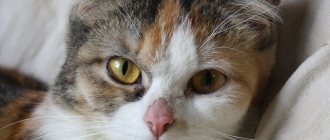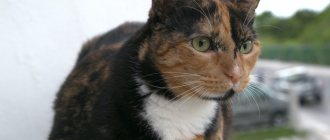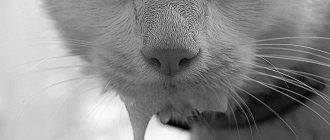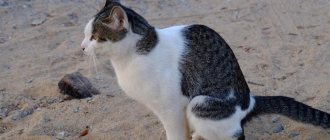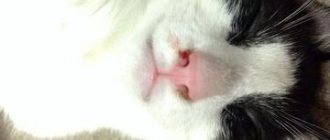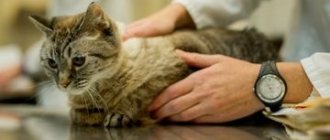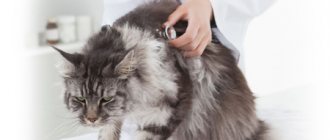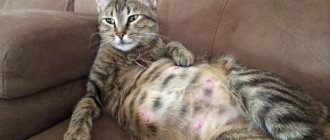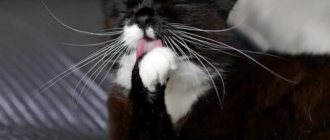Fecal incontinence occurs when a cat loses control over bowel movements. For this reason, cats may frequently defecate around the house or outside the litter box. Some pet owners confuse fecal incontinence with behavior problems and consider training their cat to use the litter box. However, since fecal incontinence is an indicator of gastrointestinal and rectal disease, pet owners should perform a veterinary examination to diagnose the underlying problem and begin treatment early.
The causes of fecal incontinence vary. Older pets may take longer to reach the litter box and therefore defecate in unusual places. Other pets may suffer from intestinal tumors, parasitic infections and lower urinary tract diseases.
Signs of incontinence
Symptoms of fecal incontinence in cats include:
- Insufficient ability of the large intestine to retain feces.
- Frequent urge to defecate. The animal often empties its intestines, and no fecal leakage is observed. False painful urges and pain during bowel movements may occur. Less commonly, bloody impurities are found in the stool.
- Increased sensitivity of the rectum, detected during endoscopic examination of the large intestine. The walls of the organ thicken, the mucous membranes thicken. The sphincter and muscle tissue of the anal area remain in normal condition. The anal reflex is not impaired.
- Presence of extensive perianal fistulas. It is observed with post-traumatic or infectious incontinence. The anal reflex is not impaired, but the outer muscle ring remains slightly open, especially if there is structural damage to the sphincter.
- Involuntary release of feces during physical activity. It is observed in diseases associated with impaired innervation of the rectum. The anal sphincter loses its tone, the reflex is weak or absent.
- Associated urinary incontinence. In combination with spontaneous defecation, it indicates disturbances in the functioning of the kitten’s nervous system.
- Loss of mobility and tone of the tail, pain in the lower spine, complete or partial paralysis of the limbs. Occurs when incontinence is caused by damage to the spinal cord. The muscles of the hind legs completely lose their tone, and there is no reaction to external stimuli.
What to do?
Drug treatment
Therapy for fecal incontinence is based on relieving the factors that contributed to the problem. If a cat experiences involuntary fecal loss, it is important for the owner to visit a veterinary clinic as soon as possible. Thanks to examinations, it will be possible to identify the cause of the pathological condition and prescribe the correct treatment regimen. If most pathologies are detected, veterinarians recommend doing frequent enemas, with the help of which it will be possible to achieve a decrease in the volume of feces and a decrease in the amount of bowel movements.
For inflammatory processes in the intestines, drug treatment with steroid drugs is used.
If a pet is diagnosed with inflammatory bowel pathologies, steroid medications are often used. When the pathological condition is caused by malfunctions of the nervous system, the cat may be prescribed surgical intervention. Opioids will help normalize intestinal motility by slowing down the passage of stool and increasing the amount of moisture absorbed from feces.
If the involuntary release of feces is associated with stress or injury, the problem may go away on its own without treatment. However, the owner will need to create the most favorable conditions for the pet. It is important not to scold your pet, to show him that he is loved. It is recommended to cover the furniture with waterproof diapers or oilcloth. If incontinence is caused by aging of the body and changes in the musculo-ligamentous apparatus, therapy is ineffective in most situations.
Diet food
If the Kurilian Bobtail or pets of other breeds suffer from fecal incontinence, it is important for owners to reconsider their diet. The following products will be useful for cats:
- rice and buckwheat cereals;
- turkey;
- chicken;
- veal;
- rabbit;
- tofu cheese;
- vegetables;
- quail and chicken eggs.
Veterinarians recommend postponing the use of ready-made industrial feeds, which are sold in stores, until the pet has fully recovered and therapeutic measures have been completed. A cat suffering from fecal incontinence needs the attention and care of its owners. They also involve preparing natural food for your pet. The cat's menu should include a sufficient amount of vitamins and microelements. Once a week it is permissible to give your pets boiled fish and fermented milk products. However, it is better to discuss the diet of a sick cat with a veterinarian. Pets can also get useful substances from vitamin-mineral complexes, which can be purchased at pharmacy chains.
Causes of the disease
The following reasons contribute to the occurrence of spontaneous bowel movements in cats:
- Decreased tone of the muscle walls of the large intestine.
- Diseases of the digestive system. Fecal incontinence is observed with colitis, irritable bowel syndrome, and the presence of malignant tumors.
- Diarrhea. When large volumes of feces are produced, the rectum loses its holding capacity, causing feces to leak.
- Injuries to the perianal area (scratches, abscesses, bites).
- Complications of surgical interventions. Incontinence occurs if the rectal wall or sphincter is damaged during surgery.
- Infectious diseases. Bacteria penetrate the fiber surrounding the rectum, causing fistulas to form through which feces are released.
- Nervous system disorders. Spontaneous defecation occurs with degenerative myelopathy, spinal cord damage, congenital defects (spinal deformity, spinal cord herniation), intervertebral hernia, trauma, inflammation of the spinal membranes. The innervation of the rectum can be disrupted when the arteries supplying the spinal cord are blocked by fibrous particles.
- Cauda equina syndrome. This term refers to a number of pathologies characterized by narrowing of the sacral part of the spinal canal. The nerve endings coming out of the spinal cord are compressed, which disrupts the functions of the rectum.
- Spondylosis. The disease is characterized by the appearance of bone growths on the vertebral plates.
- Pathological mobility of the lumbosacral spine.
- Bacterial or fungal infections of intervertebral cartilage and bone surfaces of the vertebrae.
- Benign and malignant tumors of the spinal cord.
- Neurological disorders associated with damage to the nerve endings of the perianal area. They occur against the background of infections or taking certain medications (for example, chemotherapy drugs).
- Dysfunction of the autonomic nervous system, neurological diseases of unknown origin.
- Muscular and neuromuscular pathologies.
- Aging of the body. It is accompanied by many pathological changes, for example, a decrease in the tone of the muscles responsible for controlling bowel movements, weakness of the anal sphincter, and impaired innervation.
Diagnosis of fecal incontinence in cats
In order to treat fecal incontinence, the veterinarian will determine if the problem comes from internal problems or behavioral problems. Cats in particular develop behavior problems due to unclean litter items or changes in their environment. Because behavior problems are treated differently, an accurate diagnosis is important. The veterinarian will examine the cat and palpate the abdomen to check for swelling or fluid collection. A urine test is performed to rule out bacterial urinary tract infections.
To obtain a clean urine sample, your veterinarian may perform cystocentesis and extract the urine directly from the cat's body. Because fecal incontinence is sometimes associated with neurogenic sphincter incontinence, diagnostic tests such as MRI and CT are performed to identify spinal cord lesions. A procedure known as myelography is also effective in detecting lesions in an animal's spinal cord. During a spinal cord examination, your veterinarian will look for any signs of intervertebral disc extrusion, spina bifida, and spinal injuries.
Other diagnostic tests include:
- Fecal flotation testing for parasitic infections
- Epidurography
- Biopsy
- Radiographs
- Ultrasound
© shutterstock
Treatment of the disease
If your cat spontaneously passes bowel movements, the following will help to cope with the problem:
- Warm water enemas. The procedures help reduce the volume of feces accumulating in the large intestine. The number of cases of spontaneous fecal excretion is reduced.
- Calling reflex defecation. You can empty the intestines of a paralyzed animal by pinching the tail or toe of the hind paw.
- Antibacterial therapy. Effective for incontinence caused by deep infection. Cefazolin is administered intramuscularly, which is effective against a wide range of pathogens.
- Diets. Special foods help reduce the volume of feces. The cat needs to be fed on a schedule, this allows you to control bowel movements. Foods rich in fiber are excluded from the animal’s diet.
- Surgical interventions. Surgery on the anus increases the sphincter's ability to retain feces.
- Drug therapy. Opiate-based drugs affect intestinal motility. Contractile activity of the intestine decreases, the movement of feces slows down. Liquid from the stool is absorbed, causing its volume to decrease.
- Anti-inflammatory drugs (steroid hormones, sulfasalazine). Used to treat incontinence in cats suffering from inflammatory diseases of the digestive system.
Causes
There are many reasons for fecal incontinence in cats. Most often the problem can arise as a result :
- insufficient ability of the intestines to retain feces;
- colic in the colon, cancer, irritable bowel syndrome;
- a significant volume of feces during diarrhea, when the ability to contain and absorb feces is insufficient;
- injuries, cuts, abscesses, anus bites;
- damage to the anal sphincter and muscle tissue during surgery;
- penetration of deep infection, which causes damage to the skin around the anus;
- dysfunction of muscle tissue, neuromuscular disorders;
- occurrence of perianal fistulas;
- diseases of the nervous system of various etiologies (damage to the intervertebral discs, meningomyelitis, diseases of the blood vessels, cancer, congenital pathologies);
- immune, nervous, medicinal disorders affecting the nerve endings leading to the anus, diseases whose nature is not established, dysautonomia;
- cauda equina syndrome, spondylosis, herniated intervertebral discs, penetration of bacterial infection or fungi into the intervertebral discs.
© shutterstock
A predisposition to fecal incontinence in cats may arise as a result of existing diseases of the intestines and nervous system, or operations on the rectum or sphincter.
Most often, incontinence in cats can occur after birth or is associated with old age. The older the animal, the more pronounced muscle atrophy, weakness and degenerative changes in the nervous system are.
Prevention of incontinence
Prevention of fecal incontinence in cats involves proper feeding of the pet. Food should not cause constipation or diarrhea. If an animal suffers from a neurological disease, it must be examined regularly. Timely treatment of infections and injuries plays an important role in the prevention of incontinence.
All information posted on the site is provided in accordance with the User Agreement and is not a direct instruction to action. We strongly recommend that before using any product, you must obtain a face-to-face consultation at an accredited veterinary clinic.
Neurogenic sphincter incontinence
This condition develops when a cat suffers from spinal cord injury, autonomic dysfunction, or myopathy. Pets suffering from neurogenic sphincter incontinence will exhibit symptoms of fecal incontinence. Because of this, the cat cannot retain feces in the body and suffers from involuntary bowel movements.
© shutterstock
Cats may also involuntarily pass feces when excited, stressed, or coughing. Cats that develop neurogenic sphincter incontinence require a comprehensive neurological examination to determine the type and severity of spinal injury present. If the spinal injury is treated or treated surgically, the symptoms of fecal intolerance go away.
Symptoms
There are several signs that can accurately determine that a cat is suffering from fecal incontinence.:
- The release of feces when the pet sleeps, eats or is carried away by play.
- Behavioral disturbances, the cat becomes nervous, fearful, and may show aggression.
- The animal is unable to restrain defecation by force of will. For example, a pet is sleeping, then suddenly jumps up and runs to the tray, leaving marks along the way. This happens precisely because the cat cannot hold in his feces.
Punishment in such cases is useless and pointless; it will only aggravate stress, which will contribute to the deterioration of the pet’s condition and the progression of incontinence.
© shutterstock
